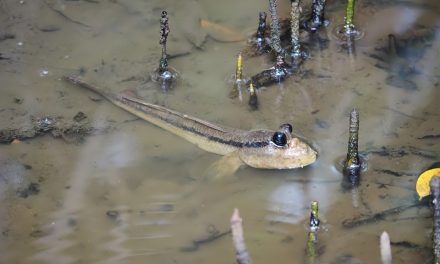Sitting on the riverbank with the same fishing pole that my Dad used as a kid, I thought about how little things had changed in fishing since then. But as I thought more, I realized just how much fishing has changed since humans discovered that fish were tasty and worth the time and energy to catch.
Fishing has evolved over the years from purely a means of subsistence using traps, spears, and nets, to a hobby supporting a multi-million-dollar industry. This transition has occurred for the most part over the last several hundred years or so.
Ancient Methods
Fish have provided sustenance to humans for as long as we have been around. Ancient men caught fish with their hands before those living in central Asia discovered that a sharp piece of bone on the end of a stick could get them dinner easier.
Prehistoric humans also carved hooks from bone and large thorns. Some of the oldest known fishhooks were found on the Island of Okinawa and date to 22,000 years ago. The line was probably fashioned from plant fiber or cocoon silk, as were early nets.
Fishing was also done with what is called a gorge. A gorge is simply a spike of wood, bone, or stone tied off-center on a line and sharpened on the ends. Bait is impaled on the gorge, and then let down to hopefully be swallowed by a fish. After the fish ingests the gorge, the line is taken in. causing the gorge to turn sideways and lodge in the stomach or esophagus, trapping the fish on the line.
The Beginnings of a Sport
Ancient Egyptian hieroglyphics show the pharaohs (and other people) fishing from boats made of reeds and indicate that fishing was possibly pursued as a hobby. The Egyptians further refined spears, nets and introduced barbed metal hooks to the world. Egyptians were also early adopters of attaching their line to a thin, flexible pole, the beginnings of the fishing rod.
The Ancient Greeks and Romans considered fishing to be a lowly activity, done to procure fish for market sale or the dining table. This stigma continued into the early medieval time when many nobles, especially in England, reserved fishing rights for themselves and prohibited the common people from taking fish from their waters.
Foundational Texts
1496 marked the printing of the first English writings on sport fishing with the publication of Treatyse of Fysshynge wyth an Angle by Juliana Berners, the head of a nunnery in southeastern England. The essay covered conservation, etiquette, rod and line construction, reading the water, and covered live bait and artificial flies.
The Treatyse was part of a book that included chapters on other gentlemanly pursuits such as hunting or hawking and was considered such a good explanation of fishing that its publisher worried about commoners reading it, believing that they would wreck the sport through excessive harvest.
In 1653 Izaak Walton wrote Compleat Angler. This poetic celebration of the sport introduced the English-speaking world to fly fishing as a sport. Many other books on fishing were published at this time, sparking an explosion in the popularity and pursuit of fly fishing as a hobby.
An Industry is Born
It was also during this time that the modern fishhook was invented by Charles Kirby and it has seen little change since. In the 1700s gear began to look more like what we see today. Ring guides appear on poles, jointed rods debuted. In 1761 a dedicated fishing shop was opened by a man named Onesimus Ustonson. He is credited with inventing or at least being the first advertiser of, the fishing reel. His store would dominate the gear supply scene in Britain into the mid-1800s.
The Industrial Revolution provided for commercially produced lines; anglers no longer had to braid their own from plant fibers or horsehair. These new textile-based lines required frequent coating to make them float and had to be dried several times per day so they would not rot or break down. At this time even more books on fishing were published, some detailing the many known fly patterns, and giving them names for the first time.
Fish biology and behavior became of interest as a way to enhance one’s catch, resulting in the research and publication of The Fly-fisher’s Entomology by Alfred Ronalds, which detailed the life cycles and timing of all the insects that trout like to feed upon.
Meanwhile in America
Us Yanks cannot leave anything alone, and fishing is no different. The first baitcasting reel was patented here in 1810, and in 1874 Orvis became the first mail-order catalog house for fishing supplies.
A Pastime for Everyman
In 1905 the spinning real was invented. A vast rail network now made it possible for the average Englishman to take a weekend holiday to fish in the county, and people took advantage of this. By mid-century, the proliferation of low-cost equipment made sportfishing a hobby that anyone could afford.
State of Fishing Today
In 2017 more than 49 million people went fishing in the US alone. These participants spent nearly 35 billion dollars in pursuit of the hobby, pumping money into local economies and generating millions in Dingell–Johnson Act funds used for the conservation of fisheries.
No longer the sport of nobility, fishing is accessible to anyone now. Gear has grown from a simple stick and line to graphite and carbon-fiber rods with ball-bearing reels and synthetic lines that last for years. Lures and baits of all types are available ready to use for a few dollars from many stores. I can go down to Walmart and buy everything that I need to get started for less than $30 (not including license). Gear is even cheaper if I go to thrift shops.
Conclusion
Fishing has evolved from being solely a means of subsistence to a sport that supports an entire industry and sometimes communities. Its accessibility makes it a common denominator between disparate and diverse groups, and it can serve as a near-universal topic of conversation to break the ice. So, who wants to go and wet a line?
- 10 Types of Fish That You Should Never Eat - May 29, 2021
- What Fish Does Caviar Come From? - May 29, 2021
- How Fishing Has Changed Over Time: A Brief History - May 29, 2021






